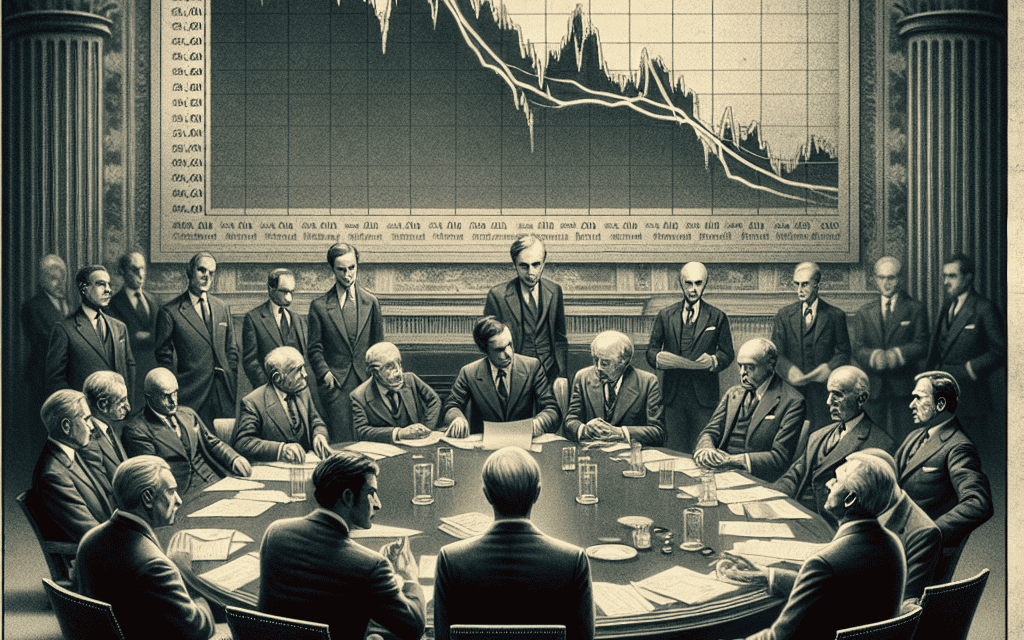“Steady Easing Ahead: Federal Reserve Plans Gradual Rate Cuts Post-Trump Election”
Introduction
Following the election of Donald Trump, the Federal Reserve has signaled a shift in its monetary policy approach, anticipating a series of gradual interest rate cuts. This strategic adjustment reflects the central bank’s response to the evolving economic landscape under the new administration. The Fed’s decision is influenced by a combination of factors, including anticipated fiscal policies, potential regulatory changes, and their projected impact on economic growth and inflation. By opting for a cautious and measured reduction in interest rates, the Federal Reserve aims to sustain economic momentum while maintaining stability in financial markets. This approach underscores the central bank’s commitment to fostering a conducive environment for continued economic expansion in the wake of political transitions.
Impact Of Trump’s Election On Federal Reserve’s Monetary Policy
The election of Donald Trump as President of the United States has ushered in a new era of economic policy, with significant implications for the Federal Reserve’s approach to monetary policy. As the Federal Reserve navigates this changing landscape, it anticipates a gradual reduction in interest rates, a move that reflects both the economic priorities of the new administration and the broader economic conditions. This anticipated shift in monetary policy is rooted in a complex interplay of factors, including the administration’s fiscal policies, global economic trends, and the Federal Reserve’s dual mandate of promoting maximum employment and stable prices.
In the wake of Trump’s election, the Federal Reserve has been closely monitoring the administration’s fiscal policy initiatives, which include tax cuts, increased infrastructure spending, and deregulation. These measures are expected to stimulate economic growth, potentially leading to higher inflationary pressures. In response, the Federal Reserve may initially adopt a cautious approach, maintaining interest rates at current levels to assess the impact of these policies on the economy. However, as the effects of fiscal stimulus become more apparent, the Federal Reserve may find it necessary to adjust its monetary policy stance to ensure that inflation remains within its target range.
Moreover, the global economic environment plays a crucial role in shaping the Federal Reserve’s monetary policy decisions. With uncertainties surrounding international trade agreements and geopolitical tensions, the Federal Reserve must consider the potential impact of these factors on the U.S. economy. A gradual reduction in interest rates could serve as a buffer against external economic shocks, providing the economy with the flexibility needed to adapt to changing global conditions. This approach aligns with the Federal Reserve’s commitment to fostering a stable economic environment that supports sustainable growth.
Furthermore, the Federal Reserve’s dual mandate of promoting maximum employment and stable prices remains a guiding principle in its decision-making process. The labor market has shown signs of strength, with unemployment rates at historically low levels. However, wage growth has been relatively modest, suggesting that there is still room for improvement in labor market conditions. By gradually reducing interest rates, the Federal Reserve aims to support continued job creation and wage growth, thereby contributing to a more robust and inclusive economic recovery.
In addition to these considerations, the Federal Reserve must also weigh the potential risks associated with a prolonged period of low interest rates. While lower rates can stimulate economic activity by making borrowing more affordable, they can also lead to asset bubbles and financial instability if not managed carefully. The Federal Reserve’s approach to rate cuts will likely be measured and data-driven, ensuring that any adjustments are made in response to concrete economic indicators rather than speculative pressures.
In conclusion, the election of Donald Trump has set the stage for a potential shift in the Federal Reserve’s monetary policy, with gradual rate cuts anticipated as a response to the administration’s fiscal policies and broader economic conditions. By carefully balancing the need for economic growth with the risks of inflation and financial instability, the Federal Reserve aims to navigate this new economic landscape effectively. As the Federal Reserve continues to assess the evolving economic environment, its commitment to promoting maximum employment and stable prices will remain at the forefront of its policy decisions, ensuring that the U.S. economy remains resilient in the face of both domestic and global challenges.
Analyzing The Federal Reserve’s Strategy For Gradual Rate Cuts
Following the recent election of Donald Trump, the Federal Reserve has signaled a potential shift in its monetary policy strategy, indicating a gradual approach to cutting interest rates. This anticipated move comes as part of a broader effort to adapt to the evolving economic landscape under the new administration. The Federal Reserve’s strategy is rooted in its dual mandate to foster maximum employment and stabilize prices, and it reflects a careful balancing act between supporting economic growth and preventing inflationary pressures.
In the wake of Trump’s election, the economic outlook has been marked by a mix of optimism and uncertainty. On one hand, the administration’s proposed policies, such as tax cuts and increased infrastructure spending, have the potential to stimulate economic activity. On the other hand, concerns about trade policies and geopolitical tensions could pose risks to economic stability. Against this backdrop, the Federal Reserve’s decision to consider gradual rate cuts is a strategic response aimed at sustaining economic momentum while mitigating potential risks.
The Federal Reserve’s approach to rate cuts is characterized by its cautious and measured nature. By opting for gradual adjustments, the central bank seeks to provide a supportive environment for economic growth without triggering runaway inflation. This strategy is informed by lessons from past economic cycles, where abrupt changes in interest rates have sometimes led to unintended consequences. By signaling its intentions clearly and adjusting rates incrementally, the Federal Reserve aims to maintain market confidence and avoid unnecessary volatility.
Moreover, the Federal Reserve’s strategy is influenced by the current state of the labor market and inflation dynamics. While the unemployment rate remains low, wage growth has been relatively modest, suggesting that there is still room for improvement in labor market conditions. At the same time, inflation has been running below the Federal Reserve’s target, providing additional justification for a gradual approach to rate cuts. By carefully monitoring these indicators, the central bank can adjust its policy stance as needed to ensure that its objectives are met.
In addition to domestic considerations, the Federal Reserve’s strategy also takes into account global economic developments. The interconnectedness of the global economy means that external factors, such as trade tensions and economic slowdowns in other regions, can have significant implications for the U.S. economy. By adopting a gradual approach to rate cuts, the Federal Reserve can better navigate these complexities and respond to international developments in a timely manner.
Furthermore, the Federal Reserve’s communication strategy plays a crucial role in the effectiveness of its monetary policy. By providing clear guidance on its intentions and the rationale behind its decisions, the central bank can help shape market expectations and reduce uncertainty. This transparency is essential for maintaining credibility and ensuring that monetary policy actions have the desired impact on the economy.
In conclusion, the Federal Reserve’s anticipated gradual rate cuts following Trump’s election reflect a strategic response to a complex and evolving economic environment. By carefully balancing the need to support growth with the imperative to maintain price stability, the central bank aims to foster a sustainable economic expansion. Through its measured approach and clear communication, the Federal Reserve seeks to navigate the challenges and opportunities presented by the new administration’s policies, while remaining vigilant to both domestic and global economic developments.
Economic Implications Of Anticipated Rate Cuts By The Federal Reserve
The recent election of Donald Trump has sparked widespread speculation regarding the future direction of U.S. economic policy, particularly concerning the Federal Reserve’s approach to interest rates. As the Federal Reserve anticipates gradual rate cuts in response to the new administration’s economic strategies, it is crucial to understand the potential implications of such monetary policy adjustments. The Federal Reserve, tasked with maintaining economic stability, often uses interest rate changes as a tool to influence economic activity. Lowering interest rates typically aims to stimulate economic growth by making borrowing cheaper, thereby encouraging spending and investment. In the context of Trump’s election, the anticipation of rate cuts suggests a strategic response to expected shifts in fiscal policy and economic priorities.
One of the primary reasons for the anticipated rate cuts is the potential for increased government spending under Trump’s administration. Historically, Trump’s economic agenda has emphasized infrastructure development and tax reforms, which could lead to a significant rise in government expenditure. Such fiscal expansion might initially boost economic growth, but it could also lead to higher inflationary pressures. In this scenario, the Federal Reserve might opt for gradual rate cuts to balance the dual mandate of promoting maximum employment and stabilizing prices. By carefully adjusting interest rates, the Federal Reserve aims to support economic growth while keeping inflation in check.
Moreover, the global economic landscape plays a crucial role in shaping the Federal Reserve’s monetary policy decisions. With Trump’s election, there is an expectation of shifts in international trade policies, which could impact global economic dynamics. Potential trade tensions or renegotiations of trade agreements might introduce uncertainties in international markets. In response, the Federal Reserve might consider rate cuts as a preemptive measure to cushion the U.S. economy from potential external shocks. By lowering interest rates, the Federal Reserve can enhance the competitiveness of U.S. exports, thereby mitigating adverse effects on the domestic economy.
Furthermore, the labor market’s performance is a critical factor influencing the Federal Reserve’s decision-making process. Under Trump’s administration, policies aimed at deregulation and tax cuts for businesses could lead to job creation and a reduction in unemployment rates. However, if wage growth accelerates too rapidly, it could contribute to inflationary pressures. In such a scenario, the Federal Reserve might implement gradual rate cuts to ensure that the labor market remains robust without triggering excessive inflation. This delicate balancing act underscores the complexity of the Federal Reserve’s role in navigating economic transitions.
In addition to domestic considerations, the Federal Reserve must also account for the actions of other central banks worldwide. As global economies are interconnected, monetary policy decisions in one country can have ripple effects across borders. If other major economies adopt accommodative monetary policies, the Federal Reserve might feel compelled to follow suit to maintain the competitiveness of the U.S. dollar. Consequently, anticipated rate cuts could be part of a broader strategy to align with global monetary trends and prevent undesirable currency fluctuations.
In conclusion, the Federal Reserve’s anticipation of gradual rate cuts following Trump’s election reflects a multifaceted approach to managing economic challenges and opportunities. By carefully calibrating interest rates, the Federal Reserve seeks to foster a stable economic environment that supports growth, employment, and price stability. As the new administration’s policies unfold, the Federal Reserve’s actions will be closely monitored, highlighting the intricate interplay between fiscal and monetary policies in shaping the nation’s economic future.
Historical Context: Federal Reserve’s Response To Presidential Elections
The Federal Reserve’s response to presidential elections has historically been a subject of considerable interest and analysis, as the central bank’s monetary policy decisions can significantly influence the economic landscape. Following the election of Donald Trump in 2016, the Federal Reserve found itself navigating a complex economic environment characterized by a mix of optimism and uncertainty. As the new administration prepared to take office, the Federal Reserve anticipated a gradual approach to adjusting interest rates, reflecting both the economic conditions at the time and the potential impact of the incoming president’s policies.
In the months leading up to the 2016 election, the U.S. economy was experiencing moderate growth, with steady job creation and low unemployment rates. However, inflation remained below the Federal Reserve’s target of 2%, prompting a cautious approach to monetary policy. The central bank had already begun a slow process of normalizing interest rates after years of maintaining them near zero in response to the financial crisis of 2008. With Trump’s election, the Federal Reserve faced the challenge of balancing its dual mandate of promoting maximum employment and stabilizing prices while considering the potential economic implications of the new administration’s policy proposals.
Trump’s campaign promises included significant tax cuts, increased infrastructure spending, and deregulation, all of which had the potential to stimulate economic growth. However, these proposals also raised concerns about increasing the federal deficit and potentially overheating the economy. In this context, the Federal Reserve anticipated that a gradual approach to rate cuts would be necessary to manage these competing pressures effectively. By signaling a cautious path forward, the central bank aimed to provide stability and predictability to financial markets, which often react sensitively to changes in monetary policy.
Moreover, the Federal Reserve’s decision-making process was influenced by the global economic environment. At the time, many advanced economies were grappling with sluggish growth and low inflation, prompting central banks worldwide to adopt accommodative monetary policies. The Federal Reserve had to consider the potential impact of its rate decisions on the U.S. dollar’s strength and the competitiveness of American exports. A gradual approach to rate cuts would help mitigate the risk of significant currency appreciation, which could have adverse effects on the U.S. trade balance.
In addition to these economic considerations, the Federal Reserve also had to navigate the political landscape. The central bank operates independently of the executive branch, but its actions are often scrutinized by political leaders and the public. Trump’s election brought heightened attention to the Federal Reserve’s role, with some of his supporters advocating for more aggressive rate cuts to spur economic growth. However, the central bank remained committed to its data-driven approach, emphasizing the importance of basing its decisions on economic indicators rather than political pressures.
In conclusion, the Federal Reserve’s response to Trump’s election was characterized by a careful and measured approach to interest rate adjustments. By anticipating gradual rate cuts, the central bank sought to balance the potential benefits of the new administration’s economic policies with the risks of inflation and financial instability. This approach underscored the Federal Reserve’s commitment to its mandate and its role as a stabilizing force in the U.S. economy, highlighting the complex interplay between monetary policy and presidential elections.
Market Reactions To The Federal Reserve’s Rate Cut Announcements
In the wake of Donald Trump’s recent election, the financial markets have been abuzz with speculation regarding the Federal Reserve’s monetary policy trajectory. The Federal Reserve, often seen as the steward of the U.S. economy, plays a pivotal role in shaping market expectations through its interest rate decisions. As the central bank anticipates a series of gradual rate cuts, market participants are keenly observing the potential implications for both domestic and global economies. Historically, the Federal Reserve’s rate cut announcements have been met with varied reactions from the markets, often reflecting the broader economic context and investor sentiment at the time.
Initially, the anticipation of rate cuts tends to inject a sense of optimism into the financial markets. Lower interest rates generally reduce borrowing costs for businesses and consumers, potentially stimulating economic activity. This expectation can lead to a rally in stock markets, as investors foresee improved corporate earnings and increased consumer spending. Moreover, sectors that are particularly sensitive to interest rates, such as real estate and consumer discretionary, often experience a surge in investor interest. However, the market’s response is not always uniformly positive. While equities may benefit, the bond market often reacts differently. As interest rates decline, bond yields typically fall, which can lead to a rise in bond prices. Yet, the prospect of lower yields may deter some investors seeking higher returns, prompting a shift in asset allocation strategies.
Furthermore, the Federal Reserve’s communication strategy plays a crucial role in shaping market reactions. Clear and consistent messaging from the central bank can help manage expectations and reduce market volatility. In recent years, the Federal Reserve has emphasized its data-dependent approach, indicating that any rate cuts will be contingent upon economic indicators such as inflation, employment, and GDP growth. This transparency aims to provide the markets with a clearer understanding of the central bank’s decision-making process, thereby minimizing uncertainty. However, unexpected economic developments or geopolitical events can still lead to abrupt shifts in market sentiment, underscoring the inherent unpredictability of financial markets.
In addition to domestic considerations, the Federal Reserve’s rate cut announcements have significant implications for global markets. As the U.S. dollar is the world’s primary reserve currency, changes in U.S. interest rates can influence capital flows and exchange rates worldwide. A series of rate cuts could lead to a depreciation of the dollar, affecting countries with significant trade ties to the United States. Emerging markets, in particular, may experience increased volatility as investors reassess risk and return profiles in light of changing U.S. monetary policy. Consequently, central banks in other countries may also adjust their policies in response to the Federal Reserve’s actions, highlighting the interconnected nature of the global financial system.
In conclusion, the Federal Reserve’s anticipated gradual rate cuts following Trump’s election are poised to have a multifaceted impact on financial markets. While the prospect of lower interest rates may bolster equities and stimulate economic activity, the bond market and global financial landscape may experience increased volatility. As market participants navigate this complex environment, the Federal Reserve’s communication strategy will be instrumental in guiding expectations and mitigating uncertainty. Ultimately, the interplay between domestic economic conditions and global market dynamics will shape the trajectory of financial markets in the months to come.
Comparing Federal Reserve Policies Before And After Trump’s Election
The Federal Reserve’s monetary policy is a critical component of the United States’ economic framework, influencing everything from inflation rates to employment levels. Before the election of Donald Trump, the Federal Reserve, under the leadership of Chair Janet Yellen, maintained a cautious approach to interest rate adjustments. This period was characterized by a gradual recovery from the 2008 financial crisis, with the Fed focusing on stabilizing the economy and fostering conditions conducive to growth. The policy decisions during this time were largely influenced by a need to balance the dual mandate of promoting maximum employment and maintaining stable prices.
In the years leading up to Trump’s election, the Federal Reserve adopted a strategy of incremental interest rate hikes. This approach was designed to prevent the economy from overheating while ensuring that inflation remained within the target range. The Fed’s cautious stance was also a response to global economic uncertainties, including fluctuating oil prices and geopolitical tensions, which necessitated a careful calibration of monetary policy to avoid derailing the economic recovery.
However, the election of Donald Trump in 2016 marked a potential shift in the economic landscape, prompting the Federal Reserve to reassess its policy trajectory. Trump’s campaign promises of tax cuts, deregulation, and increased infrastructure spending suggested a fiscal stimulus that could accelerate economic growth. In anticipation of these changes, the Federal Reserve signaled a willingness to adjust its policy stance, including the possibility of more frequent rate hikes to counteract any inflationary pressures arising from fiscal expansion.
Despite these initial expectations, the Federal Reserve’s approach post-election remained measured. The anticipated fiscal policies took time to materialize, and the Fed continued to prioritize data-driven decision-making. As the Trump administration’s economic policies began to take shape, the Federal Reserve maintained its commitment to gradualism, emphasizing the importance of monitoring economic indicators closely before making any significant policy shifts.
As the Trump presidency progressed, the Federal Reserve faced the challenge of navigating an economy that was experiencing robust growth alongside low unemployment rates. This environment necessitated a delicate balancing act, as the Fed sought to prevent the economy from overheating while avoiding any abrupt policy changes that could disrupt financial markets. Consequently, the Federal Reserve continued its strategy of gradual rate increases, underscoring its commitment to a steady and predictable policy path.
Looking ahead, the Federal Reserve anticipates a gradual approach to rate cuts, reflecting a nuanced understanding of the evolving economic conditions. This anticipated shift is informed by a recognition of potential headwinds, including trade tensions and global economic slowdowns, which could necessitate a more accommodative monetary policy stance. By signaling a readiness to adjust rates gradually, the Federal Reserve aims to provide a buffer against potential economic downturns while maintaining its focus on long-term stability.
In conclusion, the Federal Reserve’s policies before and after Trump’s election illustrate a consistent commitment to data-driven decision-making and a cautious approach to interest rate adjustments. While the election introduced new variables into the economic equation, the Fed’s emphasis on gradualism and careful monitoring of economic indicators has remained a constant. As the Federal Reserve anticipates gradual rate cuts in response to evolving economic conditions, its policies continue to reflect a careful balancing of growth and stability objectives.
Future Projections: Long-term Effects Of Gradual Rate Cuts On The Economy
Following the election of Donald Trump, the Federal Reserve has signaled a shift in its monetary policy approach, anticipating a series of gradual rate cuts. This decision marks a significant pivot from the previous trajectory of interest rate hikes, reflecting a nuanced response to evolving economic conditions. The anticipated rate cuts are expected to have profound long-term effects on the economy, influencing various sectors and stakeholders.
To begin with, the rationale behind the Federal Reserve’s decision to implement gradual rate cuts is rooted in the need to stimulate economic growth. The current economic landscape, characterized by uncertainties in global trade and fluctuating market dynamics, necessitates a more accommodative monetary policy. By lowering interest rates, the Federal Reserve aims to encourage borrowing and investment, thereby fostering economic expansion. This approach is particularly pertinent in the context of Trump’s economic policies, which emphasize deregulation and tax cuts, potentially leading to increased business activity and consumer spending.
Moreover, the anticipated rate cuts are likely to have a significant impact on the housing market. Lower interest rates typically translate into reduced mortgage rates, making homeownership more accessible to a broader segment of the population. This could lead to a surge in demand for housing, driving up property values and stimulating construction activity. Consequently, the real estate sector may experience a period of robust growth, contributing positively to the overall economy. However, it is essential to consider the potential risks associated with such growth, including the possibility of housing bubbles if demand outpaces supply.
In addition to the housing market, the financial sector is poised to experience notable changes as a result of the Federal Reserve’s policy shift. Banks and financial institutions may benefit from increased lending activity, as lower interest rates make borrowing more attractive to consumers and businesses alike. This could lead to higher profit margins for banks, as well as increased liquidity in the financial system. Nevertheless, it is crucial for financial institutions to manage risks effectively, ensuring that lending standards remain robust to prevent the accumulation of non-performing loans.
Furthermore, the anticipated rate cuts are expected to influence the behavior of investors and the performance of financial markets. Lower interest rates often lead to a search for higher yields, prompting investors to allocate capital towards equities and other riskier assets. This shift in investment patterns could result in increased stock market activity and potentially higher valuations. However, investors must remain vigilant, as market volatility may rise in response to changing economic conditions and geopolitical developments.
In the broader context, the Federal Reserve’s decision to pursue gradual rate cuts underscores the importance of maintaining a delicate balance between stimulating economic growth and safeguarding against inflationary pressures. While lower interest rates can boost economic activity, they also carry the risk of overheating the economy if not managed carefully. Therefore, the Federal Reserve must remain vigilant, ready to adjust its policy stance in response to emerging economic indicators.
In conclusion, the Federal Reserve’s anticipated gradual rate cuts following Trump’s election are poised to have significant long-term effects on the economy. By fostering economic growth through lower borrowing costs, these rate cuts have the potential to stimulate various sectors, including housing and finance. However, it is imperative for policymakers and stakeholders to remain attentive to the associated risks, ensuring that the benefits of this monetary policy approach are realized without compromising economic stability. As the economy navigates this new phase, the Federal Reserve’s actions will undoubtedly play a pivotal role in shaping the future economic landscape.
Q&A
1. **Question:** What was the Federal Reserve’s initial response to Trump’s election in terms of interest rates?
– **Answer:** The Federal Reserve initially maintained a cautious approach, opting to keep interest rates steady while assessing the potential economic impacts of Trump’s policies.
2. **Question:** How did Trump’s election influence the Federal Reserve’s economic outlook?
– **Answer:** Trump’s election led to expectations of fiscal stimulus through tax cuts and infrastructure spending, which influenced the Federal Reserve to anticipate potential economic growth and inflationary pressures.
3. **Question:** What were the Federal Reserve’s concerns regarding Trump’s proposed economic policies?
– **Answer:** The Federal Reserve was concerned about the potential for increased inflation and budget deficits resulting from Trump’s proposed tax cuts and increased government spending.
4. **Question:** How did the Federal Reserve plan to address potential inflationary pressures following Trump’s election?
– **Answer:** The Federal Reserve anticipated a gradual increase in interest rates to manage potential inflationary pressures while supporting economic growth.
5. **Question:** What was the market’s reaction to the Federal Reserve’s anticipated rate cuts following Trump’s election?
– **Answer:** The market reacted with increased volatility, as investors adjusted their expectations for economic growth and inflation based on the Federal Reserve’s anticipated monetary policy adjustments.
6. **Question:** How did the Federal Reserve’s anticipated rate cuts align with its dual mandate?
– **Answer:** The anticipated rate cuts were aligned with the Federal Reserve’s dual mandate of promoting maximum employment and stabilizing prices, as they aimed to support economic growth while keeping inflation in check.
7. **Question:** What factors could influence the Federal Reserve’s decision to implement gradual rate cuts following Trump’s election?
– **Answer:** Factors influencing the decision could include actual economic growth rates, inflation data, labor market conditions, and the implementation and impact of Trump’s fiscal policies.
Conclusion
Following Trump’s election, the Federal Reserve anticipated a gradual approach to rate cuts, reflecting a cautious strategy to balance economic growth with inflation control. The expectation of rate cuts was likely influenced by the administration’s fiscal policies, which aimed to stimulate the economy through tax reforms and deregulation. The Fed’s approach suggested a focus on sustaining economic expansion while being mindful of potential overheating. This strategy underscored the Fed’s role in maintaining economic stability amid changing political landscapes, highlighting its commitment to data-driven decision-making and its adaptability to new economic policies.





